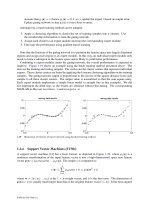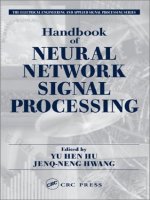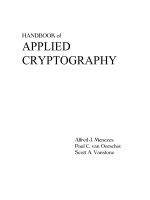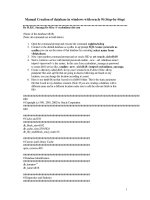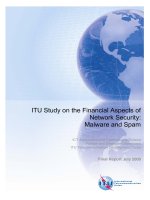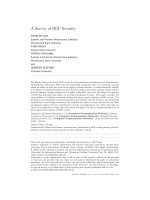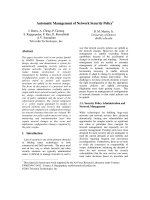handbook of database security - applications & trends
Bạn đang xem bản rút gọn của tài liệu. Xem và tải ngay bản đầy đủ của tài liệu tại đây (7.52 MB, 579 trang )
Handbook of
Database Security
Applications and Trends
Handbook of
Database Security
Applications and Trends
edited by
Michael Gertz
University of California at Davis
USA
Sushil Jajodia
George Mason University
USA
Michael Gertz Sushil Jajodia
University of California at Davis George Mason University
Dept. of Computer Science Center for Secure Information Systems
One Shields Avenue Research I, Suite 417
Davis, CA 95616-8562 Fairfax VA 22030-4444
Library of Congress Control Number: 2007934795
ISBN-13: 978-0-387-48532-4
e-ISBN-13: 978-0-387-48533-1
Printed on acid-free paper.
c
2008 Springer Science+Business Media, LLC.
All rights reserved. This work may not be translated or copied in whole or in part without the written
permission of the publisher (Springer Science+Business Media, LLC, 233 Spring Street, New York,
NY 10013, USA), except for brief excerpts in connection with reviews or scholarly analysis. Use in
connection with any form of information storage and retrieval, electronic adaptation, computer software,
or by similar or dissimilar methodology now known or hereafter developed is forbidden.
The use in this publication of trade names, trademarks, service marks and similar terms, even if they are
not identified as such, is not to be taken as an expression of opinion as to whether or not they are subject
to proprietary rights.
987654321
springer.com
Preface
Motivation for the book
Database security has been gaining a great deal of importance as industry, military,
and government organizations have increasingly adopted Internet-based technolo-
gies on a large-scale, because of convenience, ease of use, and the ability to take
advantage of rapid advances in the commercial market. Along with the traditional
security aspects of data integrity and availability, there is an increasing interest in
research and development in data privacy. This is because today’s often mission-
critical databases no longer contain only data used for day-to-day processing by
organization; as new applications are being added, it is possible for organizations to
collect and store vast amounts of data quickly and efficiently and to make the data
readily accessible to the public, typically through Web-based applications. Unfortu-
nately, if security threats related to the integrity, availability, and privacy of the data
are not properly resolved, databases remain vulnerable to malicious attacks and ac-
cidental misuse. Such incidents, in turn, may translate into financial losses or losses
whose values are obviously high but difficult to quantify, e.g., the loss of the public’s
trust in the data management infrastructure and services offered by an organization.
In assembling this handbook, we have had a twofold objective: first, to provide
a comprehensive summary of the results of research and development activities in
various aspects of database security up to this point, and second, to point toward
directions for future work in this important and fruitful field of research.
This handbook offers twenty three essays contributed by a selected group of
prominent researchers. Given the dynamic nature of the field of database security,
we have attempted to obtain a balance among various viewpoints by inviting multi-
ple contributions on the same topic. We believe that this diversity provides a richness
generally not available in one book. In some cases, authors have tried to reconcile
their differences by contributing a single essay on a topic.
v
vi Preface
About the book
Essays in this handbook can be roughly divided into following eight areas:
Foundations of Access Control
• Recent Advances in Access Control by Sabrina De Capitani di Vimercati, Sara
Foresti, and Pierangela Samarati
• Access Control Models for XML by Sabrina De Capitani di Vimercati, Sara
Foresti, Stefano Paraboschi, and Pierangela Samarati
• Access Control Policy Languages in XML by Naizhen Qi and Michiharu Kudo
Trust Management and Trust Negotiation
• Database Issues in Trust Management and Trust Negotiation by Dongyi Li,
William Winsborough, Marianne Winslett, and Ragib Hasan
Secure Data Outsourcing
• Authenticated Index Structures for Outsourced Databases by Feifei Li, Marios
Hadjileftheriou, George Kollios, and Leonid Reyzin
• Towards Secure Data Outsourcing by Radu Sion
• Managing and Querying Encrypted Data by Bijit Hore, Sharad Mehrotra, and
Hakan Hacıg
¨
um
¨
us¸
Security in Advanced Database Systems and Applications
• Security in Data Warehouses and OLAP Systems by Lingyu Wang and Sushil
Jajodia
• Security for Workflow Systems by Vijayalakshmi Atluri and Janice Warner
• Secure Semantic Web Services by Bhavani Thuraisingham
• Geospatial Database Security by Soon Ae Chun and Vijayalakshmi Atluri
• Security Re-engineering for Databases: Concepts and Techniques by Michael
Gertz and Madhavi Gandhi
Database Watermarking
• Database Watermarking for Copyright Protection by Radu Sion
• Database Watermarking: A Systematic View by Yingjiu Li
Trustworthy Record Retention and Recovery
• Trustworthy Records Retention by Ragib Hasan, Marianne Winslett, Soumyadeb
Mitra, Windsor Hsu, and Radu Sion
• Damage Quarantine and Recovery in Data Processing Systems by Peng Liu,
Sushil Jajodia, and Meng Yu
Preface vii
Privacy
• Hippocratic Databases: Current Capabilities and Future Trends by Tyrone Gran-
dison, Christopher Johnson, and Jerry Kiernan
• Privacy-Preserving Data Mining: A Survey by Charu C. Aggarwal and Philip S.
Yu
• Privacy in Database Publishing: A Bayesian Perspective by Alin Deutsch
• Privacy Preserving Publication: Anonymization Frameworks and Principles by
Yufei Tao
Privacy in Location-based Services
• Privacy Protection through Anonymity in Location-based Services by Claudio
Bettini, Sergio Mascetti, and X. Sean Wang
• Privacy-enhanced Location-based Access Control by Claudio A. Ardagna, Marco
Cremonini, Sabrina De Capitani di Vimercati, and Pierangela Samarati
• Efficiently Enforcing the Security and Privacy Policies in a Mobile Environment
by Vijayalakshmi Atluri and Heechang Shin
Intended audience
This handbook is suitable as a reference for practitioners and researchers in indus-
try and academia who are interested in the state-of-the-art in database security and
privacy. Instructors may use this handbook as a text in a course for upper-level un-
dergraduate or graduate students. Any graduate student who is interested in database
security and privacy must definitely read this book.
Acknowledgements
We are extremely grateful to all those who contributed to this handbook. It is a
pleasure to acknowledge the authors for their contributions. Special thanks go to
Susan Lagerstrom-Fife, Senior Publishing Editor for Springer, and Sharon Palleschi,
Editorial Assistant at Springer, whose enthusiasm and support for this project were
most helpful.
Davis, California, and Fairfax, Virginia Michael Gertz
September 2007 Sushil Jajodia
Contents
1 Recent Advances in Access Control 1
Sabrina De Capitani di Vimercati, Sara Foresti, and Pierangela Samarati
2 Access Control Models for XML 27
Sabrina De Capitani di Vimercati, Sara Foresti, Stefano Paraboschi, and
Pierangela Samarati
3 Access Control Policy Languages in XML 55
Naizhen Qi and Michiharu Kudo
4 Database Issues in Trust Management and Trust Negotiation 73
Dongyi Li, William Winsborough, Marianne Winslett and Ragib Hasan
5 Authenticated Index Structures for Outsourced Databases 115
Feifei Li, Marios Hadjileftheriou, George Kollios, and Leonid Reyzin
6 Towards Secure Data Outsourcing 137
Radu Sion
7 Managing and Querying Encrypted Data 163
Bijit Hore, Sharad Mehrotra, and Hakan Hacıg
¨
um
¨
us¸
8 Security in Data Warehouses and OLAP Systems 191
Lingyu Wang and Sushil Jajodia
9 Security for Workflow Systems 213
Vijayalakshmi Atluri and Janice Warner
10 Secure Semantic Web Services 231
Bhavani Thuraisingham
11 Geospatial Database Security 247
Soon Ae Chun and Vijayalakshmi Atluri
ix
x Contents
12 Security Re-engineering for Databases: Concepts and Techniques 267
Michael Gertz and Madhavi Gandhi
13 Database Watermarking for Copyright Protection 297
Radu Sion
14 Database Watermarking: A Systematic View 329
Yingjiu Li
15 Trustworthy Records Retention 357
Ragib Hasan, Marianne Winslett, Soumyadeb Mitra, Windsor Hsu, and
Radu Sion
16 Damage Quarantine and Recovery in Data Processing Systems 383
Peng Liu, Sushil Jajodia, and Meng Yu
17 Hippocratic Databases: Current Capabilities and Future Trends 409
Tyrone Grandison, Christopher Johnson, and Jerry Kiernan
18 Privacy-Preserving Data Mining: A Survey 431
Charu C. Aggarwal and Philip S. Yu
19 Privacy in Database Publishing: A Bayesian Perspective 461
Alin Deutsch
20 Privacy Preserving Publication: Anonymization Frameworks and
Principles 489
Yufei Tao
21 Privacy Protection through Anonymity in Location-based Services 509
Claudio Bettini, Sergio Mascetti, and X. Sean Wang
22 Privacy-enhanced Location-based Access Control 531
Claudio A. Ardagna, Marco Cremonini, Sabrina De Capitani di
Vimercati, and Pierangela Samarati
23 Efficiently Enforcing the Security and Privacy Policies in a Mobile
Environment 553
Vijayalakshmi Atluri and Heechang Shin
Index 575
List of Contributors
Charu C. Aggarwal
IBM T. J. Watson Research Center, Hawthorne, NY, e-mail:
Claudio A. Ardagna
Dipartimento di Tecnologie dell’Informazione, Universit
`
a degli Studi di Milano,
Crema, Italy, e-mail:
Vijayalakshmi Atluri
Rutgers University, Newark, NJ, e-mail:
Claudio Bettini
DICo, University of Milan, Italy, e-mail:
Sabrina De Capitani di Vimercati
Dipartimento di Tecnologie dell’Informazione, Universit
`
a degli Studi di Milano,
Crema, Italy, e-mail:
Soon Ae Chun
City University of New York, College of Staten Island, Staten Island, NY, e-mail:
Marco Cremonini
Dipartimento di Tecnologie dell’Informazione, Universit
`
a degli Studi di Milano,
Crema, Italy, e-mail:
Alin Deutsch
Department of Computer Science and Engineering, University of California San
Diego, La Jolla, CA, e-mail:
Sara Foresti
Dipartimento di Tecnologie dell’Informazione, Universit
`
a degli Studi di Milano,
Crema, Italy, e-mail:
xi
xii List of Contributors
Madhavi Gandhi
Department of Mathematics and Computer Science, California State University,
East Bay, CA, e-mail:
Michael Gertz
Department of Computer Science, University of California at Davis, Davis, CA,
e-mail:
Tyrone Grandison
IBM Almaden Research Center, San Jose, CA, e-mail:
Hakan Hacıg
¨
um
¨
us¸
IBM Almaden Research Center, San Jose, CA, e-mail:
Marios Hadjileftheriou
AT&T Labs Inc., e-mail:
Ragib Hasan
Department of Computer Science, University of Illinois at Urbana-Champaign, IL,
e-mail:
Bijit Hore
Donald Bren School of Computer Science, University of California, Irvine, CA,
e-mail:
Windsor Hsu
Data Domain, Inc., e-mail:
Sushil Jajodia
Center for Secure Information Systems, George Mason University, Fairfax, VA,
e-mail:
Christopher Johnson
e-mail:
Jerry Kiernan
IBM Almaden Research Center, San Jose, CA, e-mail:
George Kollios
Computer Science Department, Boston University, Boston, MA, e-mail:
Michiharu Kudo
Tokyo Research Laboratory, IBM, Japan, e-mail:
Dongyi Li
Department of Computer Science, University of Texas at San Antonio, TX, e-mail:
Feifei Li
Department of Computer Science, Florida State University, FL, e-mail:
List of Contributors xiii
Yingjiu Li
School of Information Systems, Singapore Management University, 80 Stamford
Road, Singapore, e-mail:
Peng Liu
Pennsylvania State University, PA, e-mail:
Sergio Mascetti
DICo, University of Milan, Italy, e-mail:
Sharad Mehrotra
Donald Bren School of Computer Science, University of California, Irvine, CA,
e-mail:
Soumyadeb Mitra
Department of Computer Science, University of Illinois at Urbana-Champaign, IL,
e-mail:
Stefano Paraboschi
University of Bergamo, Dalmine, Italy, e-mail:
Naizhen Qi
Tokyo Research Laboratory, IBM, Japan, e-mail:
Leonid Reyzin
Computer Science Department, Boston University, Boston, MA, e-mail:
Pierangela Samarati
Dipartimento di Tecnologie dell’Informazione, Universit
`
a degli Studi di Milano,
Crema, Italy, e-mail:
Heechang Shin
Rutgers University, Newark, NJ, e-mail:
Radu Sion
Network Security and Applied Cryptography Lab, Stony Brook University, NY,
e-mail:
Yufei Tao
Department of Computer Science and Engineering, Chinese Univer-
sity of Hong Kong, Sha Tin, New Territories, Hong Kong, e-mail:
Bhavani Thuraisingham
University of Texas at Dallas, TX, e-mail:
Lingyu Wang
Concordia Institute for Information Systems Engineering, Concordia University,
Montreal, QC H3G 1M8, Canada, e-mail:
X. Sean Wang
Department of Computer Science, University of Vermont, VT, e-mail:
xiv List of Contributors
Janice Warner
Rutgers University, Newark, NJ, e-mail:
William Winsborough
Department of Computer Science, University of Texas at San Antonio, TX, e-mail:
Marianne Winslett
Department of Computer Science, University of Illinois at Urbana-Champaign, IL,
e-mail:
Meng Yu
Western Illinois University, Macomb, IL, e-mail:
Philip S. Yu
IBM T. J. Watson Research Center, Hawthorne, NY, e-mail:
1
Recent Advances in Access Control
S. De Capitani di Vimercati, S. Foresti, and P. Samarati
Dipartimento di Tecnologie dell’Informazione
Universit`a degli Studi di Milano
26013 Crema, Italy
{decapita,foresti,samarati}@dti.unimi.it
Summary. Access control is the process of mediating every request to resources
and data maintained by a system and determining whether the request should be
granted or denied. Traditional access control models and languages result limiting
for emerging scenarios, whose open and dynamic nature requires the development
of new ways of enforcing access control. Access control is then evolving with the
complex open environments that it supports, where the decision to grant an access
may depend on the properties (attributes) of the requestor rather than her identity
and where the access control restrictions to be enforced may come from different
authorities. These issues pose several new challenges to the design and implemen-
tation of access control systems. In this chapter, we present the emerging trends in
the access control field to address the new needs and desiderata of today’s systems.
1 Introduction
Information plays an important role in any organization and its protection
against unauthorized disclosure (secrecy) and unauthorized or improper mod-
ifications (integrity), while ensuring its availability to legitimate users (no
denials-of-service) is becoming of paramount importance. An important ser-
vice in guaranteeing information protection is the access control service. Ac-
cess control is the process of mediating every request to resources and data
maintained by a system and determining whether the request should be
granted or denied. An access control system can be considered at three dif-
ferent abstractions of control: access control policy , access control model,and
access control mechanism. A policy defines the high level rules used to verify
whether an access request is to be granted or denied. A policy is then formal-
ized through a security model and is enforced by an access control mechanism.
The separation between policies and mechanisms has a number of advantages.
First, it is possible to discuss protection requirements independently of their
implementation. Second, it is possible to compare different access control poli-
cies as well as different mechanisms that enforce the same policy. Third, it is
possible to design access control mechanisms able to enforce multiple policies.
2 S.DeCapitanidiVimercati,S.Foresti,andP.Samarati
In this way, a change in the access control policy does not require any changes
in the mechanism. Also, the separation between model and mechanism makes
it possible to formally prove security properties on the model; any mechanism
that correctly enforces the model will then enjoy the same security properties
proved for the model.
The variety and complexity of the protection requirements that may need
to be imposed in today’s systems makes the definition of access control policies
a far from trivial process. An access control system should be simple and
expressive. It should be simple to make easy the management task of specifying
and maintaining the security specifications. It should be expressive to make
it possible to specify in a flexible way different protection requirements that
may need to be imposed on different resources and data. Moreover, an access
control system should include support for the following features.
• Policy combination. Since information may not be under the control of a
single authority, access control policies information may take into consider-
ation the protection requirements of the owner, but also the requirements
of the collector and of other parties. These multiple authorities scenario
should be supported from the administration point of view providing solu-
tions for modular, large-scale, scalable policy composition and interaction.
• Anonymity. Many services do not need to know the real identity of a user.
It is then necessary to make access control decisions dependent on the
requester’s attributes, which are usually proved by digital certificates.
• Data outsourcing. A recent trend in the information technology area is rep-
resented by data outsourcing, according to which companies shifted from
fully local management to outsourcing the administration of their data by
using externally service providers [1, 2, 3]. Here, an interesting research
challenge consists in developing an efficient mechanism for implementing
selective access to the remote data.
These features pose several new challenges to the design and implementa-
tion of access control systems. In this chapter, we present the emerging trends
in the access control field to address the new needs and desiderata of today’s
systems. The remainder of the chapter is organized as follows. Section 2 briefly
discusses some basic concepts about access control, showing the main charac-
teristics of the discretionary, mandatory, and role-based access control policies
along with their advantages and disadvantages. Section 3 introduces the prob-
lem of enforcing access control in open environments. After a brief overview
of the issues that need to be addressed, we describe some proposals for trust
negotiation and for regulating service access. Section 4 addresses the problem
of combining access control policies that may be independently stated. We
first describe the main features that a policy composition framework should
have and then illustrate some current solutions. Section 5 presents the main
approaches for enforcing selective access in an outsourced scenario. Finally,
Sect. 6 concludes the chapter.
Recent Advances in Access Control 3
Document1 Document2 Program1 Program2
Ann read, write read execute
Bob read read read, execute
Carol read, write read, execute
David read, write, execute read, write, execute
Fig. 1. An example of access matrix
2 Classical Access Control Models
Classical access control models can be grouped into three main classes: dis-
cretionary access control (DAC), which bases access decisions on users’ iden-
tity; mandatory access control (MAC), which bases access decisions on man-
dated regulations defined by a central authority; and role-based access control
(RBAC), which bases access decisions on the roles played by users in the mod-
els. We now briefly present the main characteristics of these classical access
control models.
2.1 Discretionary Access Control
Discretionary access control is based on the identity of the user requesting
access and on a set of rules, called authorizations, explicitly stating which
user can perform which action on which resource. In the most basic form, an
authorization is a triple (s, o, a), stating that user s can execute action a on
object o. The first discretionary access control model proposed in the literature
is the access matrix model [4,5,6].LetS, O,andA be a set of subjects,
objects, and actions, respectively. The access matrix model represents the set
of authorizations through a |S|×|O| matrix A.EachentryA[s, o] contains the
list of actions that subject s can execute over object o. Figure 1 illustrates an
example of access matrix where, for example, user Ann can read and write
Document1.
The access matrix model can be implemented through different mecha-
nisms. The straightforward solution exploiting a two-dimensional array is not
viable, since A is usually sparse. The mechanisms typically adopted are:
• Authorization table. The non empty entries of A are stored in a table with
three attributes: user, action,andobject.
• Access control list (ACL). The access matrix is stored by column, that
is, each object is associated with a list of subjects together with a set of
actions they can perform on the object.
• Capability. The access matrix is stored by row, that is, each subject is
associated with a list indicating, for each object, the set of actions the
subject can perform on it.
Figure 2 depicts the authorization table, access control lists, and capability
lists corresponding to the access matrix of Fig. 1.
4 S.DeCapitanidiVimercati,S.Foresti,andP.Samarati
User Action Object
Ann read Document1
Ann write Document1
Ann read Document2
Ann execute Program1
Bob read Document1
Bob read Document2
Bob read Program1
Bob execute Program1
Carol read Document2
Carol write Document2
Carol execute Program2
David read Program1
David write Program1
David execute Program1
David read Program2
David write Program2
David execute Program2
(a)
Document1
Ann
read
write
Bob
read
Document2
Ann
read
Bob
read
Carol
read
write
Program1
Ann
execute
Bob
read
David
read
writeexecute
execute
Program2
Carol
execute
David
read
write
execute
(b)
Ann
Document1
read
write
Bob
Carol
David
Document2
read
Program1
execute
Document1
read
Document2
read
Program1
read
execute
Document2
read
write
Program2
execute
Program1
read
write
Program2
execute
read
write
execute
(c)
Fig. 2. Access matrix implementation mechanisms
From the access matrix model, discretionary access control systems have
evolved and they include support for the following features.
• Conditions. To make authorization validity depend on the satisfaction of
some specific constraints, today’s access control systems typically support
conditions associated with authorizations. [5]. For instance, conditions im-
pose restrictions on the basis of: object content (content-dependent condi-
tions), system predicates (system-dependent conditions), or accesses pre-
viously executed (history-dependent conditions).
Recent Advances in Access Control 5
Personnel
Administration
Medical
Nurse
Doctor
Ann Bob Carol
David
Fig. 3. An example of user-group hierarchy
• Abstractions. To simplify the authorization definition process, discre-
tionary access control supports also user groups and classes of objects,
which may also be hierarchically organized. Typically, authorizations spec-
ified on an abstraction propagate to all its members according to different
propagation policies [7]. Figure 3 illustrates an example of user-group hi-
erarchy. Here, for example, an authorization specified for the Nurse group
applies also to Bob and Carol.
• Exceptions. The definition of abstractions naturally leads to the need of
supporting exceptions in authorization definition. Suppose, for example,
that all users belonging to a group but u can access resource r. If exceptions
were not supported, it would be necessary to associate an authorization
with each user in the group but u, therefore not exploiting the possibility
of specifying the authorization of the group. This situation can be easily
solved by supporting both positive and negative authorizations: the system
would have a positive authorization for the group and a negative autho-
rization for u.
The introduction of both positive and negative authorizations brings to
two problems: inconsistency, when conflicting authorizations are associ-
ated with the same element in a hierarchy; and incompleteness, when
some accesses are neither authorized nor denied.
Incompleteness is usually easily solved by assuming a default policy,open
or closed (this latter being more common), where no authorization applies.
In this case, an open policy approach allows the access, while the closed
policy approach denies it.
To solve the inconsistency problem, different conflict resolution policies
have been proposed [7, 8], such as:
– No conflict. The presence of a conflict is considered an error.
– Denials take precedence. Negative authorizations take precedence.
– Permissions take precedence. Positive authorizations take precedence.
– Nothing takes precedence. Conflicts remain unsolved.
– Most specific takes precedence. An authorization associated with an
element n overrides a contradicting authorization (i.e., an authoriza-
tion with the same subject, object, and action but with a different
sign) associated with an ancestor of n for all the descendants of n.For
instance, consider the user-group hierarchy in Fig. 3 and the autho-
6 S.DeCapitanidiVimercati,S.Foresti,andP.Samarati
S, {Admin, Medical}
S, {Admin}
U, {Admin, Medical} S, {Medical}
U, {Admin}
S, {}
U, {Medical}
U, {}
(a)
C, {Admin, Medical}
C, {Admin}
I, {Admin, Medical} C, {Medical}
I, {Admin}
C, {}
I, {Medical}
I, {}
(b)
Fig. 4. An example of security (a) and integrity (b) lattices
rizations (Medical,Document1,+r) and (Nurse,Document1,−r). Carol
cannot read Document1, since the Nurse group is more specific than
the Medical group.
– Most specific along a path takes precedence. An authorization associ-
ated with an element n overrides a contradicting authorization asso-
ciated with an ancestor n
for all the descendants of n, only for the
paths passing from n. The overriding has no effect on other paths. For
instance, with respect to the previous example, Carol gains a positive
authorization from the path Medical,Doctor,Carol, and a negative
one from path Nurse,Carol.
While convenient for their expressiveness and flexibility, in high security
settings discretionary access control results limited for its vulnerability to
Trojan horses. The reason for this vulnerability is that discretionary access
control does not distinguish between users (i.e., human entity whose identity
is exploited to select the privileges for making the access control decision) and
subjects (i.e., process generated by a user and that makes requests to the sys-
tem). A discretionary access control system evaluates the requests made by a
subject against the authorizations of the user who generated the correspond-
ing process. It is then vulnerable from processes executing malicious programs
that exploit the authorizations of the user invoking them. Protection against
these processes requires controlling the flows of information within processes
execution and possibly restricting them. Mandatory policies provide a way to
enforce information flow control through the use of labels.
2.2 Mandatory Access Control
Mandatory security policies enforce access control on the basis of regulations
mandated by a central authority. The most common form of mandatory policy
is the multilevel security policy, based on the classifications of subjects and
objects in the system. Each subject and object in the system is associated with
an access class, usually composed of a security level and a set of categories.
Security levels in the system are characterized by a total order relation, while
Recent Advances in Access Control 7
categories form an unordered set. As a consequence, the set of access classes
is characterized by a partial order relation, denoted ≥ and called dominance.
Given two access classes c
1
and c
2
, c
1
dominates c
2
, denoted c
1
≥ c
2
,iffthe
security level of c
1
is greater than or equal to the security level of c
2
and
the set of categories of c
1
includes the set of categories of c
2
. Access classes
together with their partial order dominance relationship form a lattice [9].
Mandatory policies can be classified as secrecy-based and integrity-based,
operating in a dual manner.
Secrecy-Based Mandatory Policy [10, 11, 12, 13]. The main goal of secrecy-
based mandatory policies is to protect data confidentiality. As a consequence,
the security level of the access class associated with an object reflects the
sensitivity of its content, while the security level of the access class associated
with a subject, called clearance, reflects the degree of trust placed in the
subject not to reveal sensitive information. The set of categories associated
with both subjects and objects defines the area of competence of users and
data. A user can connect to the system using her clearance or any access class
dominated by her clearance. A process generated by a user connected with a
specific access class has the same access class as the user.
The access requests submitted by a subject are evaluated by applying the
following two principles.
No-Read-Up. A subject s can read an object o if and only if the access class
of the subject dominates the access class of the object.
No-Write-Down. A subject s can write an object o if and only if the access
class of the object dominates the access class of the subject.
Consider, as an example, the security lattice in Fig. 4(a), where there
are two security levels, Secret (S)andUnclassified (U), with S>U,and
the set of categories {Admin, Medical}. Suppose that user Ann has clearance
S,{Admin} and she connects to the system as the S,{} subject. She is
allowed to read objects S,{} and U,{}. She can write objects with access
class S,{}, S,{Admin}, S,{Medical},andS
,{Admin,Medical}.
Note that a user is allowed to connect to the system at different access
classes to the aim of accessing information at different levels (provided that
she is cleared for it). Otherwise, these accesses would be blocked by the no-
write-down principle.
The principles of the secrecy-based mandatory policy prevent information
flows from high level subjects/objects to subjects/objects at lower (or incom-
parable) levels, thus preserving information confidentiality. However, these
two principles may turn out to be too restrictive. For instance, in a real sce-
nario data may need to be downgraded (e.g., this may happen at the end of
the embargo). To consider also these situations, the secrecy-based mandatory
models can allow exceptions for processes that are trusted and ensure that
the information produced is sanitized.
8 S.DeCapitanidiVimercati,S.Foresti,andP.Samarati
Integrity-Based Mandatory Policy [14]. The main goal of integrity-based
mandatory policies is to prevent subjects from indirectly modifying informa-
tion they cannot write. The integrity level associated with a user reflects then
the degree of trust placed in the subject to insert and modify sensitive infor-
mation. The integrity level associated with an object indicates the degree of
trust placed on the information stored in the object and the potential damage
that could result from unauthorized modifications of the information. Again,
the set of categories associated with both subjects and objects defines the
area of competence of users and data.
The access requests submitted by a subject are evaluated by applying the
following two principles.
No-Read-Down. A subject s can read an object o if and only if the integrity
class of the object dominates the integrity class of the subject.
No-Write-Up. A subject s can write an object o if and only if the integrity
class of the subject dominates the integrity class of the object.
Consider, as an example, the integrity lattice in Fig. 4(b), where there
are two integrity levels Crucial (C)andImportant (I), with C>I, and the
set of categories {Admin, Medical}. Suppose that user Ann connects to the
system as the C,{Admin} subject. She can read objects having integrity class
C,{Admin} and C,{Admin,Medical} and she can write objects with integrity
class C,{Admin}, C, {}, I,{Admin},andI,{}.
These two principles are the dual with respect to the principles adopted by
secrecy-base policies. As a consequence, the integrity model prevents flows of
information from low level objects to higher objects. A major limitation of this
model is that it only captures integrity breaches due to improper information
flows. However, integrity is a much broader concept and additional aspects
should be taken into account [15].
Note that secrecy-based and integrity-based models are not mutually ex-
clusive, since it may be useful to protect both the confidentiality and the
integrity properties. Obviously, in this case, objects and subjects will be as-
sociated with both a security and an integrity class.
A major drawback of mandatory policies is that they control only flows
of information happening through overt channels, that is, channels operating
in a legitimate way. As a consequence, the mandatory policies are vulnerable
to covert channels [16], which are channels not intended for normal commu-
nication but that still can be exploited to infer information. For instance, if a
low level subject requests the use of a resource currently used by a high level
subject, it will receive a negative response, thus inferring that another (higher
level) subject is using the same resource.
2.3 Role-Based Access Control
A third approach for access control is represented by Role-Based Access Con-
trol (RBAC) models [17, 18]. A role is defined as a set of privileges that any
Recent Advances in Access Control 9
user playing that role is associated with. When accessing the system, each user
has to specify the role she wishes to play and, if she is granted to play that
role, she can exploit the corresponding privileges. The access control policy is
then defined through two different steps: first the administrator defines roles
and the privileges related to each of them; second, each user is assigned with
the set of roles she can play. Roles can be hierarchically organized to exploit
the propagation of access control privileges along the hierarchy.
A user may be allowed to simultaneously play more than one role and
more users may simultaneously play the same role, even if restrictions on
their number may be imposed by the security administrator.
It is important to note that roles and groups of users are two different
concepts. A group is a named collection of users and possibly other groups,
and a role is a named collection of privileges, and possibly other roles. Fur-
thermore, while roles can be activated and deactivated directly by users at
their discretion, the membership in a group cannot be deactivated.
The main advantage of RBAC, with respect to DAC and MAC, is that
it better suits to commercial environments. In fact, in a company, it is not
important the identity of a person for her access to the system, but her re-
sponsibilities. Also, the role-based policy tries to organize privileges mapping
the organization’s structure on the roles hierarchy used for access control.
3 Credential-Based Access Control
In an open and dynamic scenario, parties may be unknown to each other and
the traditional separation between authentication and access control cannot
be applied anymore. Such parties can also play the role of both client, when
requesting access to a resource, and server for the resources it makes available
for other users in the system. Advanced access control solutions should then
allow to decide, on one hand, which requester (client) is to be granted access
to the resource, and, on the other hand, which server is qualified for providing
the same resource. Trust management has been developed as a solution for
supporting access control in open environments [19]. The first approaches
proposing a trust management solution for access control are PolicyMaker [20]
and KeyNote [21]. The key idea of these proposals is to bind public keys to
authorizations and to use credentials to describe specific delegations of trust
among keys. The great disadvantage of these early solutions is that they assign
authorizations directly to users’ keys. The authorization specification is then
difficult to manage and, moreover, the public key of a user may act as a
pseudonym of herself, thus reducing the advantages of trust management,
where the identity of the users should not be considered.
The problem of assigning authorizations directly to keys has been solved
by the introduction of digital certificates. A digital certificate is the on-line
counterpart of paper credentials (e.g., a driver licence). A digital certificate is
a statement, certified by a trusted entity (the certificate authority), declaring
10 S. De Capitani di Vimercati, S. Foresti, and P. Samarati
a set of properties of the certificate’s holder (e.g., identity, accreditation, or
authorizations). Access control models, by exploiting digital certificates for
granting or denying access to resources, make access decisions on the basis of
a set of properties that the requester should have. The final user can prove to
have such properties by providing one or more digital certificates [22, 23, 24,
25, 26].
The development and effective use of credential-based access control mod-
els require however tackling several problems related to credential manage-
ment and disclosure strategies, delegation and revocation of credentials, and
establishment of credential chains [27, 28, 29, 30]. In particular, when devel-
oping an access control system based on credentials, the following issues need
to be carefully considered [22].
• Ontologies. Since there is a variety of security attributes and requirements
that may need to be considered, it is important to guarantee that different
parties will be able to understand each other, by defining a set of common
languages, dictionaries, and ontologies.
• Client-side and server-side restrictions. Since parties may act as either a
client or a server, access control rules need to be defined both client-side
and server-side.
• Credential-based access control rules. New access control languages sup-
porting credentials need to be developed. These languages should be both
expressive (to define different kinds of policies) and simple (to facilitate
policy definition).
• Access control evaluation outcome. The resource requester may not be
aware of the attributes she needs to gain access to the requested resource.
As a consequence, access control mechanisms should not simply return a
permit or deny answer, but should be able to ask the final user for the
needed credentials to access the resource.
• Trust negotiation strategies. Due to the large number of possible alternative
credentials that would enable an access request, a server cannot formulate
a request for all these credentials, since the client may not be willing to
release the whole set of her credentials. On the other hand, the server
should not disclose too much of the underlying security policy, since it
may contain sensitive information.
In the following, we briefly describe some proposals that have been devel-
oped for trust negotiation and for regulating service access in open environ-
ments.
3.1 Overview of Trust Negotiation Strategies
As previously noted, since the interacting parties may be unknown to each
other, the resource requester may not be aware of the credentials necessary
for gaining access privileges. Consequently, during the access control process,
Recent Advances in Access Control 11
the two parties exchange information about the credentials needed for access.
The access control decision comes then after a complex process, where par-
ties exchange information not only related to the access itself, but also to
additional restrictions imposed by the counterpart. This process, called trust
negotiation, has the main goal of establishing trust between the interacting
parties in an automated manner. A number of trust negotiation strategies
have been proposed in the literature, which are characterized by the following
steps.
• The client first requests to access a resource.
• The server then checks if the client provided the necessary credentials. In
case of a positive answer, the server grants access to the resource; otherwise
it communicates the client the policies that she has to fulfill.
• The client selects the requested credentials, if possible, and sends them to
the server.
• If the credentials satisfy the request, the client is granted access to the
resource.
This straightforward trust negotiation process suffers of privacy problems,
since both the server discloses its access control policy entirely and the client
exposes all her certificates to gain access to a resource. To solve such an
inconvenience, a gradual trust establishment process can be enforced [31]. In
this case, upon receiving an access request, the server selects the policy that
governs the access to the service and discloses only the information that it is
willing to show to an unknown party. The client, according to its practices,
decides if it is willing to disclose the requested credentials. Note that this
incremental exchange of requests and credentials can be iteratively repeated
as many times as necessary.
PRUdent NEgotiation Strategy (PRUNES) is another negotiation strat-
egy whose main goal is to minimize the number of certificates that the client
communicates to the server [30]. It also ensures that the client communicates
her credentials to the server only if the access will be granted. Each party
defines a set of credential policies on which the negotiation process is based.
The established credential policies can be graphically represented through a
tree, called negotiation search tree, composed of two kinds of nodes: credential
nodes, representing the need for a specific credential, and disjunctive nodes,
representing the logic operators connecting the conditions for credential re-
lease. The root of the tree represents the resource the client wants to access.
The negotiation process can be seen as a backtracking operation on the tree.
To the aim of avoiding the cost of a brute-force backtracking, the authors pro-
pose the PRUNES method to prune the search tree without compromising
completeness or correctness of the negotiation process. The basic idea is that
if a credential has just been evaluated and the state of the system has not
changed too much, then it is useless to evaluate again the same credential.
A large set of negotiation strategies, called disclosure tree strategy (DTS)
family [32], has been also defined and proved to be closed. This means that,
12 S. De Capitani di Vimercati, S. Foresti, and P. Samarati
if two parties use different strategies from the DST family, they will be able
to negotiate trust. A Unified Schema for Resource Protection (UniPro) [33]
has been proposed to protect the information specified within policies. UniPro
gives (opaque) names to policies and allows any named policy P
1
to have its
own policy P
2
, meaning that the content of P
1
can only be disclosed to parties
who satisfy P
2
. Another solution is the Adaptive Trust Negotiation and Access
Control (ATNAC) approach [34]. This method grants (or denies) access on
the basis of a suspicion level associated with subjects. The suspicion level
is not fixed but may vary on the basis of the probability that the user has
malicious intents.
It is important to note that in recent, more complicated, scenarios disclo-
sure policies can be defined both on resources and on credentials [22]. In this
case, the client, upon receiving a request for a certificate, can answer with a
counter-request to the server for another certificate.
3.2 Overview of a Credential-Based Access Control Framework
One of the first solutions providing a uniform framework for credential-based
access control specification and enforcement was presented by Bonatti and
Samarati [22]. The proposed access control system includes an access control
model, a language, and a policy filtering mechanism.
The paper envisions a system composed of two entities: a client and a
server, interacting through a predefined negotiation process. The server is
characterized by a set of resources. Both the client and the server have a port-
folio, which is a collection of credentials (i.e., statements issued by authorities
trusted for making them [35]) and declarations (statements issued by the party
itself). Credentials correspond to digital certificates and are guaranteed to be
unforgeable and verifiable through the public key of the issuing authority.
To the aim of performing gradual trust establishment between the two
interacting parties, the server defines a set of service accessibility rules,and
both the client and the server define their own set of portfolio disclosure rules.
The service accessibility rules specify the necessary and sufficient conditions
for accessing a resource, while portfolio disclosure rules define the conditions
that govern the release of credentials and declarations. Both the two classes
of rules are expressed by using a logic language. A special class of predicates
is represented by abbreviations. Since there may exist a number of alternative
combinations of certificates allowing access to a resource, abbreviation pred-
icates may be used for reducing the communication cost of such certificates.
The predicates of the language adopted exploit the current state (i.e., parties’
characteristics, certificates already exchanged in the negotiation, and requests
made by the parties) to take a decision about a release. The information about
the state is classified as persistent state, when the information is stored at the
site and spans different negotiations, and negotiation state, when it is acquired
during the negotiation and is deleted when the same terminates.


